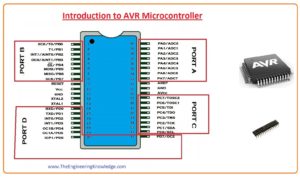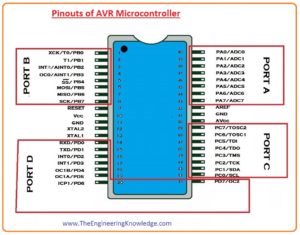 Hello readers I hope you all are doing great and enjoying your life. In today’s post, we will have a detailed look at Introduction to AVR Microcontroller. The AVR is a group of microcontrollers in 1996 the first time it was created by the Atmel. which was the first time created in 1996 and after that it was obtained by the American company Microchip Technology in 2016. It is based on Harvard architecture and eight-bit RISC (reduced instruction set computer) having a single chip.
Hello readers I hope you all are doing great and enjoying your life. In today’s post, we will have a detailed look at Introduction to AVR Microcontroller. The AVR is a group of microcontrollers in 1996 the first time it was created by the Atmel. which was the first time created in 1996 and after that it was obtained by the American company Microchip Technology in 2016. It is based on Harvard architecture and eight-bit RISC (reduced instruction set computer) having a single chip.
This is the first microcontroller that uses flash memory for data storage while other controllers were used older types of memories for data storage such as ROM, EPROM, EEPROM. There is numerous common applications such as embedded systems in which it used. In today’s post, we will have a detailed look at its working, pinout, features, and some other related parameters. So let’s get started with Introduction to AVR Microcontroller.
Introduction to AVR Microcontroller
- The AVR is a type of MCUs which is created by the Atmel this controller provides numerous features that are lacking in other types of MCUs.
- This microcontroller is like our personal computer which has different types of elements such as EEPROM, RAM, microprocessor, all these and some other components are exits on this board.
- These modules are available in different types of arrangements such as surface mounting and hole mounting.
- This controller comes with eight to one hundred pinouts configurations the type of AVR which has sixty-four pinouts is available in surface mount.
- In 2006 microcontroller of thirty-two-bit having AVR32 structure. This module has a different structure than the eight-bit AVR controller and was a competitor of the processor based on ARM.
- This module comprises of thirty-two-bit data buses and uses SIMD and DSP commands with some other factors.
- This controller comprises of flash memory, EEPROM, and static random access memory all these memories are assembled on the single board.
- At some controllers, there is a port for a parallel exterior bus which used to connected some extra memory if required.
- In all types of AVRs except TinyAVR there is serial interfacing exist which helps to connect EEPROM having large space.
Features of AVR Microcontroller
- These are some main features of AVR microcontroller which are described here with the details.
- This module performs numerous functions that have two-directional inputs and output ports which can be configured with the pull-up resistances.
- There are numerous inner oscillators, consisting of RC oscillators also exits on this board.
- There is a flash memory of two fifty kilobyte storage space exits on this board.
- The EEPROM having space of four-kilo byte is assembled on this board.
- The static random access memory having space of sixteen kilobytes is exist on this board.
- There are 2 timers of eight bit and sixteen-bit exits on this board.
- The pulse width modulation output exists on this board.
- There is an analog comparator also assembled on this module.
- There is twelve bit analog to digital converter with the multiplex having sixteen channels exist on this board.
- There is a twelve bit digital to analog converter that exists on this board.
- It uses I2C and TWI interfacing for communication.
- Its operating voltage is 1.8 volts.
Pinouts of AVR Microcontroller
- This pinout of this board are described here with the details.
Port A
- This port comprises of PA0 to PA7 pinouts.
- These pinouts of this port operate as analog inputs for analog to digital converter.
- This port can also be used as an eight-bit two-directional input and output port in absence of analog to digital converter.
Port B
- In this port there are pinouts from PB0 to PB7 are exist. It is eight-bit two-dimensional input and output which comprises of pull up resistance.
Port C
- In this port PC0 to PC7 pinouts are exist. It is also eight-bit two-dimension input and output having inner pull up resistance.
Port D
- In this port the pinouts from PD0 to PD7 exist, This port is also eight-bit two-dimension input and output port having inner pull up resistance
RESET
- This pinout is used to reset the controller.
XTAL1
- It used as input to the inverting oscillator amplifier and also used as input pinout to the inner clock circuitry.
AVcc
- This pin is used to provide voltage to the port A and analog to digital converter.
AREF
- This pinout is used as a reference pinout for analog to digital converter.
Applications of AVR Microcontroller
- These are some important applications of AVR microcontrollers.
- It used in different types of embedded systems.
- It used in electronic devices,
- It used in industries for the control of different machines
So friends that is a detailed post about AVR microcontroller if you have any further questions ask in comments. Thanks for reading. Have a good day







